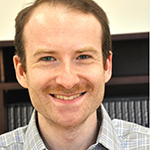FACULTY
 |
Eugene Serebryany, PhD |
|
Research |
My main interest is the biophysics of protein misfolding in vivo and mechanisms of misfolding-associated diseases, discovery and pharmacological targeting of physiologically relevant non-native protein conformations, and protein engineering in currently inaccessible environments. To enable these lines of research, I develop new experimental methods at the interface of molecular biophysics and chemical biology and closely collaborate with computational biophysicists for computational-experimental integration.. Recent Research Outputs We introduced a new technology in protein science: high-throughput disulfide scanning of protein conformations to map conformational landscapes to phenotypic landscapes in vivo. Achieving this required solving a partial case of the grand challenge of single-molecule protein deep sequencing: precisely locating the sequence positions of both Cys simultaneously in each double-Cys variant polypeptide. We elucidated a biochemical mechanism of protein aggregation in the eye lens, which leads to cataract: a redox-driven “inverse-prion” aggregation phenotype, wherein wild-type human γD-crystallin dramatically promotes aggregation of its oxidation-mimicking W42Q variant. We showed that this reaction involves transfer of disulfide bonds from the C-terminal domain of the WT to the N-terminal domain of the mutant, locking the latter in an aggregation-prone conformation. This work has helped change our understanding of lens crystallin biochemistry by realizing that proteins formerly considered inert in fact have oxidoreductase activity and likely serve as a protein-based redox buffer in aging lens. We opened the way to a potential first non-surgical treatment for age-onset cataracts. It reports that a highly abundant metabolite in the human eye lens, myo-inositol, has the previously unrecognized function of suppressing cataract-associated lens crystallin aggregation. Notably, many prior efforts to develop an anti-cataract therapeutic fell victim to the steep challenge of drug delivery to lens tissue; native myo-inositol transporters in the lens give this compound or its derivatives a natural advantage in this regard. We elucidated important aspects of the interaction between lens crystallins and transition metal ions, leading to pronounced aggregation but also formation of extraordinarily long-lived free radicals in human lens γD-crystallin, which has implications for protein-based radical chemistry during the process of lens aging and cataract development.
|
|
Recent Publications |
Serebryany, E.*; Zhao, V. Y.; Park, K.; Bitran, A.; Trauger, S. A.; Budnik, B; Shakhnovich, E. I.* “Systematic conformation-to-phenotype mapping via limited deep-sequencing of proteins.” *joint corresponding authors. (2023) Molecular Cell. 83:11, 1936-57. Bitran, A.†; Park, K.†; Serebryany, E.; Shakhnovich, E. I. “Cotranslational formation of disulfides guides folding of the SARS COV-2 receptor binding domain.” †equal contribution. (2023) Biophysical Journal 122(16):3238-3253. Palomino-Vizcaino, G.; Dominguez-Calva, J. A.; Schuth, N.; Martinez-Jurado, E.; Rodriguez-Mesa, O.; Serebryany, E.; King, J. A.; Kroll, T.; Costas, M.; Quintanar, L. “Copper reductase activity and free radical chemistry by cataract-associated human lens γ-crystallins.” (2023) Journal of the American Chemical Society 145:12, 6781-97. Serebryany, E.; Chowdhury, S.; Woods, C. N.; Thorn, D. C.; Watson, N. E.; McClelland, A.; Klevit, R. E.; Shakhnovich, E. I. “A native chemical chaperone in the human eye lens.” (2022) eLife 11:e76923. Serebryany, E.*; Thorn, D. C.; Quintanar, L. “Redox chemistry of lens crystallins: A system of cysteines.” *corresponding author. (2021) Experimental Eye Research 211:108707. Mills-Henry, I. A.; Thol, S. L.; Kosinski-Collins, M. S.; Serebryany, E.*; King, J. A. “Kinetic stability of long-lived human gamma-D and gamma-S crystallins and their isolated double Greek Key domains. *corresponding author. (2019) Biophysical Journal 117:2, 269-280. Serebryany, E.; Yu, S.; Trauger, S. A.; Budnik, B.; Shakhnovich, E. I. “Dynamic disulfide exchange in a human eye lens crystallin promotes cataract-associated aggregation.” (2018) Journal of Biological Chemistry 293:46, 17997-18009.
|

